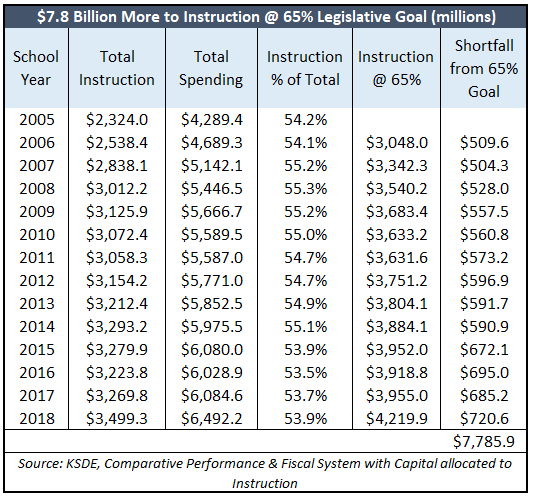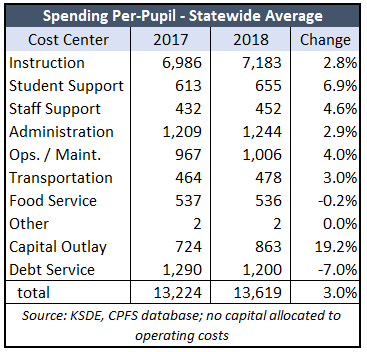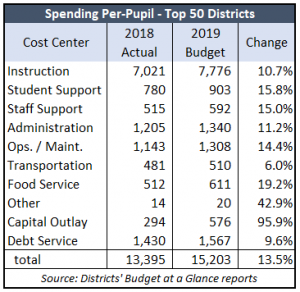There’s universal agreement that nothing impacts learning more than the interaction between students and teachers, yet local school boards allocated just 53.9 percent of total spending to Instruction during the 2018 school year. The Kansas Department of Education (KSDE), defines Instruction as “direct interaction between students and teachers.”
 When the Kansas Supreme Court ordered an $853 million funding increase in 2005, the Legislature encouraged school boards to put most of the money into Instruction by passing a policy recommendation urging 65 percent of total funding to go towards Instruction. Local school boards ignored the Legislature and reduced the allocation from 54.2 percent to the current level.
When the Kansas Supreme Court ordered an $853 million funding increase in 2005, the Legislature encouraged school boards to put most of the money into Instruction by passing a policy recommendation urging 65 percent of total funding to go towards Instruction. Local school boards ignored the Legislature and reduced the allocation from 54.2 percent to the current level.
The Kansas Association of School Boards likes to claim far larger spending allocations to ‘the classroom’ by counting other spending but there is no official state or federal definition of “classroom;’ that’s merely an attempt to deflect attention from what is actually spent on what has the greatest influence on student achievement – direct interaction betweeen students and teachers.
Had local school boards done so each year, $7.8 billion more would have been spent on Instruction since 2005. Immediately going to 65 percent may not have been practical, but even raising the allocation by a half percentage point each year until reaching the target would have resulted in $4.9 billion more being spent on Instruction.
 Data downloaded from KSDE’s Comparative Performance and Fiscal System (CPFS) shows that school boards increased Instruction spending per-pupil last year by a smaller degree (2.8 percent) than most other cost centers. Capital Outlay had the largest increase at 19.2 percent, followed by Student Support (6.9 percent), Staff Support (4.6 percent), Operations & Maintenance (4 percent), Transportation (3 percent) and Administration (2.9 percent).
Data downloaded from KSDE’s Comparative Performance and Fiscal System (CPFS) shows that school boards increased Instruction spending per-pupil last year by a smaller degree (2.8 percent) than most other cost centers. Capital Outlay had the largest increase at 19.2 percent, followed by Student Support (6.9 percent), Staff Support (4.6 percent), Operations & Maintenance (4 percent), Transportation (3 percent) and Administration (2.9 percent).
Administration was the second-largest spending category last year, at $1,244 per-pupil and accounting for a little over 9 percent of total spending. Debt Service was the third highest category at $1,200 per-pupil.
Total spending per-pupil loaded to CPFS increased 3 percent to $13,619; that’s $1 less than the official total reported by KSDE because there’s always a small discrepancy between the two sources each year.
Spending by cost center for every school district is available here at KansasOpenGov.org; charts showing the percentage spent by each district on Instruction are here.
2019 Budgets
A review of the 50 largest districts’ “Budget at a Glance” reports posted to their web sites shows continued de-emphasis on Instruction. Per-pupil spending on Instruction is budgeted to grow by 10.7 percent to $7,776 but that’s a smaller increase than every other cost center except Transportation, with a 6 percent gain.
 Instruction averaged 52.4 percent of total spending for those districts last year, but the allocation is budgeted to drop to 51.1 percent this year.
Instruction averaged 52.4 percent of total spending for those districts last year, but the allocation is budgeted to drop to 51.1 percent this year.
The 50 largest districts accounted for 73 percent of all students last year and 71 percent of total spending. Almost half of those 50 districts are budgeting much smaller increases for Instruction than Administration this year. A few of the more eye-opening examples include Blue Valley in Johnson County (8 percent for Instruction, 32 percent for Administration), Topeka (21 percent and 36 percent), Haysville (2 percent and 32 percent), Wichita (5 percent and 11 percent), Hutchinson (5 percent and 22 percent) and McPherson (6 percent and 56 percent).
The Legislature doesn’t tell local school boards how to allocate spending, there is no requirement to spend money efficiently and no consequence to districts for failing to improve student achievement. For those reasons, the last big court-ordered funding increase resulted is districts doing generally the same things but at much higher costs and it appears that history is about to be repeated; the adults in the system will get nice pay increases and student achievement will continue to be unacceptably low and not much different than 20 years ago.
It will be interesting to see if the next Legislature and Governor muster the political will to stand up to the education lobby and implement real accountability measures – or if they will continue to allow Einstein’s definition of insanity to play out while waiting for the next multi-billion dollar lawsuit to be filed.




